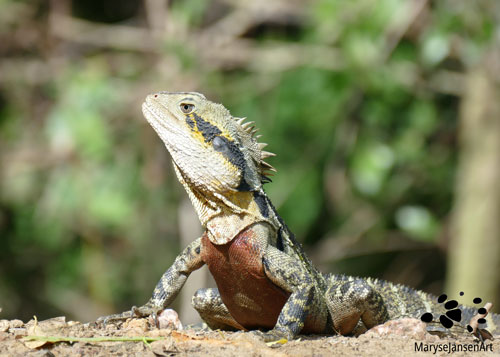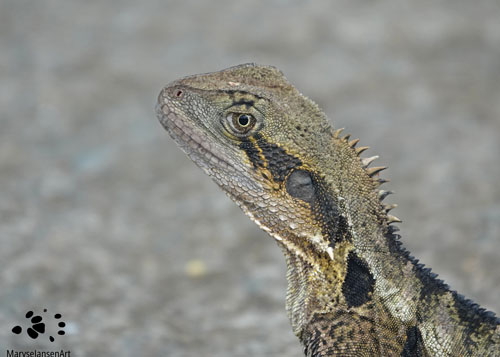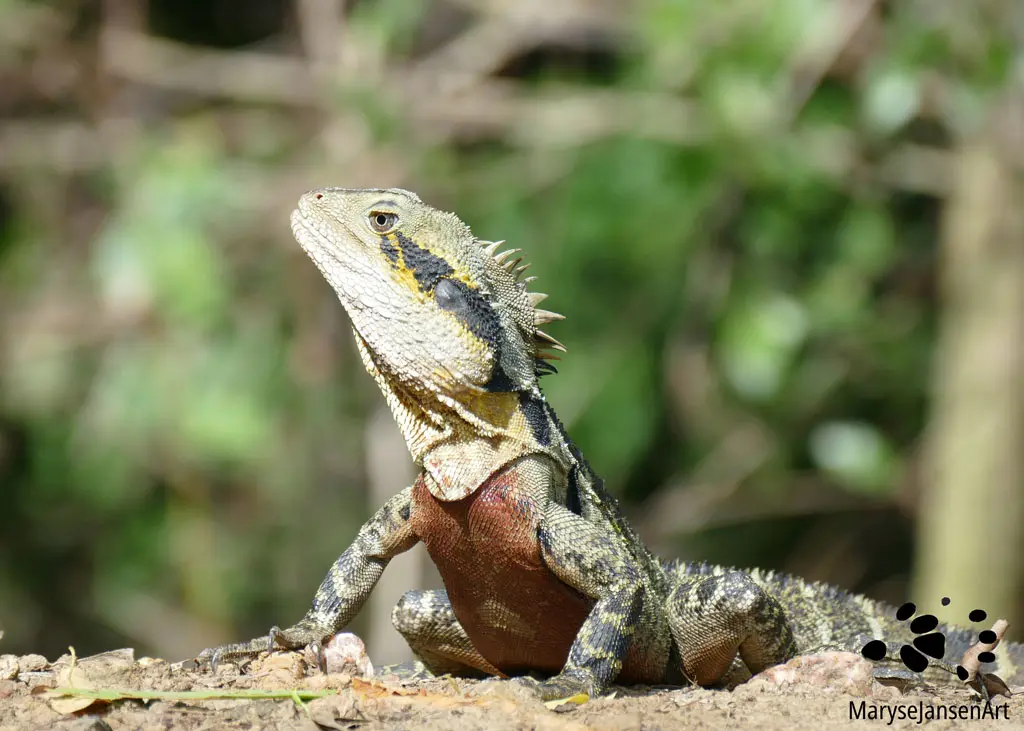Wildlife Photography with marysejansenart
Ancient looking lizard likes to show off

Table of Contents
Ancient Dragons in the middle of the big city
My first encounter with Eastern Water Dragons was in the middle of Brisbane, just after I arrived in Australia. It was not exactly what I expected to see in the middle of a big city. But on the south bank of the Brisbane River is an area of parklands, including lots of water features and a tropical rainforest section. Apparently the ideal habitat for these animals as there were many!
The Eastern Water Dragon is a semi-aquatic lizard and prefers to hang out and sunbathe on rocks or in trees near the water. When it feels threatened it is quick to disappear into the water.
Naturally they are very shy animals, but in areas like these they have gotten quite used to the presence of people and it’s a lot easier to get a closer look at them. I was quite fascinated, I had never seen anything like it. And it’s true, the Water Dragons are quite unique, being the only species in the genus Intelligama (which means ‘Intelligent Lizard’ by the way). They are by far the largest Dragon species in Australia, reaching up to 90cm in length!
The spiny crest that runs all the way from the head to the tail, combined with their angular head-shape makes them look like an ancient creature. And in a way, that’s exactly what they are! Fossils have been found that suggest that very similar creatures lived in Australia 20 million years ago!!
The four well developed limbs enable the upright posture of the dragons. They are even able to walk on their hind limbs only, which they sometimes do when they break out into a run! Also they have a long, strong, flattened tail that assists them in swimming. They absolutely are strong swimmers and also have the capacity to stay submerged for a long time – up to an hour or more!!!

Territorial males
I notice that some dragons are a lot bigger than the others and have an intense red colouring on their chest and the black stripe on their cheek is thicker too. These are the dominant males. The other dragons – the females and the younger males – have a creamy white chest. In the featured image you can see a male showing off his red chest.
The dominant males puff up their red chests to intimidate other males that try to compete for their territory and females. They make themselves as tall as they can and may also open their mouth wide. I also see them trying to chase the other males away. Most of the time this display of strength and domination will be enough to get rid of the competition. In the case that the other party is not impressed a fight may follow.
When humans come too close to them they don’t like it either and might display a similar behaviour, so it’s better to keep a respectful distance! They have a good bite and may also scratch with their sharp claws. The females and younger dragons are usually quite shy and make a run for it if you get too close.
Water Dragons communicate with each other using body signals such as head-bobbing, tail-flicking and arm-waving. It is thought that these signals are used to establish dominance versus submission.
Breeding Season
The Water Dragons live in groups where one dominant male has a harem of females. The dragons become sexually mature at about an age of five years old. Spring is the mating season. The females dig 10-15cm deep holes in the soil, away from the water, in which they lay their eggs. There are 10-20 eggs in a clutch. After laying, the females fill the hole back up with soil and scatter some loose debris over it. You would never know the nest was there!
It takes three months before the eggs hatch. The temperature of the nest determines the sexe of the young, just like with crocodiles. When they are born they hang around near the nest for some time but these youngsters do have to fend for themselves straight away.
During the summer months it can literally be teeming with Water Dragons in locations they have colonised such as South Bank. Animals of all shapes and sizes occupy themselves in their territory and can be seen foraging for food on the land or in the water. But most of their time is spent basking in the sun, or simply lounging in trees or on rocks.
When disturbed, a Water Dragon might simply run away and seek cover in thick vegetation. Otherwise it will drop into the water and stay submerged until the danger has passed. An alternative tactic is to remain completely frozen, hoping that they won’t be seen. The younger dragons prefer to stay on the ground and are more skittish then the older, bigger ones.
Eating and being eaten
Young dragons are completely insectivorous. They may catch insects from the ground or vegetation and catch mosquitoes from the air. As they grow older they begin to add more plant matter to their diet, including vegetation as well as flowers, fruits and berries. They will also eat molluscs, yabbies, small reptiles, frogs, small mammals and worms so they become true omnivores!
Eastern Water Dragons have a short, thick tongue which they can use to catch their food. This differentiates them from the other lizards which tend to only use their jaws to grab their food.
The main predators of Eastern Water Dragons are snakes and carnivorous birds. Adult dragons have been known to cannibalize on the little ones. Water Dragons may fall prey to feral cats, dogs and foxes as well. Most predators go for the younger dragons, so once they’re fully grown they are a bit safer. They can live up to 20 years!
Living with the seasons
It’s early autumn at the time of writing and the weather is still warm. The new Eastern Water Dragon generation is growing fast. They do most of their growing within the first year. Once the cooler winter months hit the dragons will go in brumation (a type of hibernation). They will dig burrows between boulders and logs nearby their beloved water and close the entrance with dirt. For a couple of months you wouldn’t know they were there. But when spring comes, they will emerge again, the story of the breeding season will repeat, and before you know it you might be tripping over them again in places like South Bank!
If you are interested in purchasing ‘Showing Off’ or would like to see what the image looks like on the various products, please head to my shop. If you prefer ‘Eastern Water Dragon Portrait’, click shop here. Or check out more amazing images in my Australian Reptiles collection here.
Check out below the latest episode in my ‘Come for a walk in the Australian Bush’-series, featuring some of these amazing Water Dragons!
NEW!!! More amazing footage of the Eastern Water Dragons:


